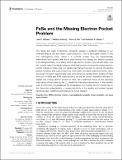Files in this item
FeSe and the missing electron pocket problem
Item metadata
| dc.contributor.author | Rhodes , Luke C. | |
| dc.contributor.author | Eschrig , Matthias | |
| dc.contributor.author | Kim , Timur K. | |
| dc.contributor.author | Watson , Matthew D. | |
| dc.date.accessioned | 2022-05-16T12:31:27Z | |
| dc.date.available | 2022-05-16T12:31:27Z | |
| dc.date.issued | 2022-05-09 | |
| dc.identifier | 279615909 | |
| dc.identifier | 1e79b04a-3da7-4ac5-9487-df7120d501e4 | |
| dc.identifier | 85130728739 | |
| dc.identifier | 000800548500001 | |
| dc.identifier.citation | Rhodes , L C , Eschrig , M , Kim , T K & Watson , M D 2022 , ' FeSe and the missing electron pocket problem ' , Frontiers in Physics , vol. 10 , 859017 . https://doi.org/10.3389/fphy.2022.859017 | en |
| dc.identifier.issn | 2296-424X | |
| dc.identifier.other | Bibtex: 10.3389/fphy.2022.859017 | |
| dc.identifier.other | ORCID: /0000-0003-2468-4059/work/113398650 | |
| dc.identifier.uri | https://hdl.handle.net/10023/25380 | |
| dc.description | LR acknowledges funding from the Royal Commission for the Exhibition 1851. | en |
| dc.description.abstract | The nature and origin of electronic nematicity remains a significant challenge in our understanding of the iron-based superconductors. This is particularly evident in the iron chalcogenide, FeSe, where it is currently unclear how the experimentally determined Fermi surface near the M point evolves from having two electron pockets in the tetragonal state, to exhibiting just a single electron pocket in the nematic state. This has posed a major theoretical challenge, which has become known as the missing electron pocket problem of FeSe, and is of central importance if we wish to uncover the secrets behind nematicity and superconductivity in the wider iron-based superconductors. Here, we review the recent experimental work uncovering this nematic Fermi surface of FeSe from both ARPES and STM measurements, as well as current theoretical attempts to explain this missing electron pocket of FeSe, with a particular focus on the emerging importance of incorporating the dxy orbital into theoretical descriptions of the nematic state. Furthermore, we will discuss the consequence this missing electron pocket has on the theoretical understanding of superconductivity in this system and present several remaining open questions and avenues for future research. | |
| dc.format.extent | 22 | |
| dc.format.extent | 4674330 | |
| dc.language.iso | eng | |
| dc.relation.ispartof | Frontiers in Physics | en |
| dc.subject | FeSe | en |
| dc.subject | ARPES | en |
| dc.subject | Electronic strucutre | en |
| dc.subject | Superconductivity | en |
| dc.subject | Nematicity | en |
| dc.subject | Strong correlations | en |
| dc.subject | Iron based superconductors | en |
| dc.subject | QC Physics | en |
| dc.subject | TK Electrical engineering. Electronics Nuclear engineering | en |
| dc.subject | T-NDAS | en |
| dc.subject.lcc | QC | en |
| dc.subject.lcc | TK | en |
| dc.title | FeSe and the missing electron pocket problem | en |
| dc.type | Journal article | en |
| dc.contributor.institution | University of St Andrews. School of Physics and Astronomy | en |
| dc.identifier.doi | 10.3389/fphy.2022.859017 | |
| dc.description.status | Peer reviewed | en |
This item appears in the following Collection(s)
Items in the St Andrews Research Repository are protected by copyright, with all rights reserved, unless otherwise indicated.

